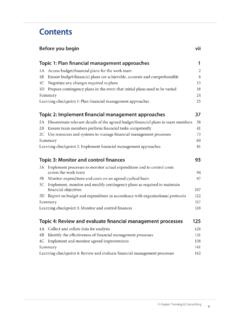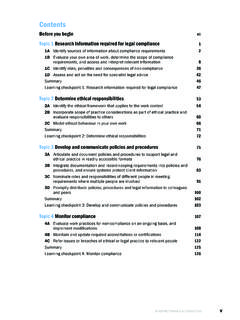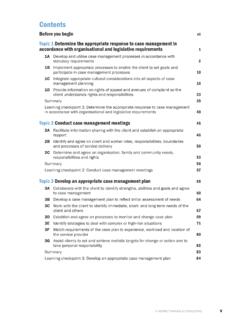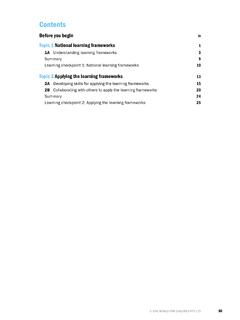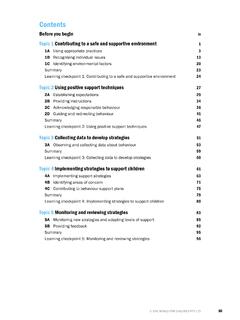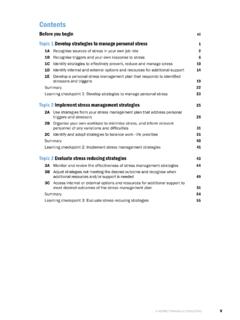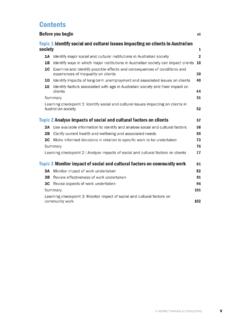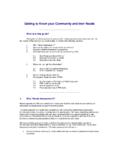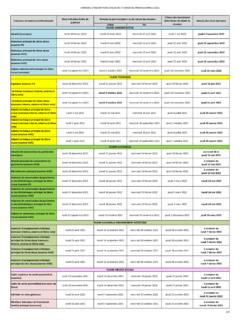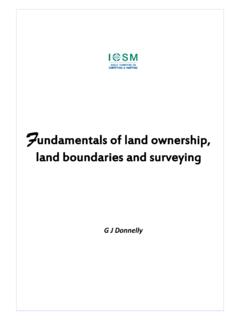Transcription of BSBWOR301 Organise personal work priorities and …
1 Aspire Training & ConsultingvContentsBefore you begin viiTopic 1: Organise and complete own work schedule 11A Understand and negotiate work goals, objectives and KPIs 21B Assess and prioritise workload to ensure timely completion of tasks 191C Identify factors affecting the achievement of work objectives 251D Use business technology to manage and monitor tasks 31 Summary39 Learning checkpoint 1: Organise and complete own work schedule 40 Topic 2: Monitor own work performance 472A Monitor and adjust personal work performance 482B Seek and evaluate feedback on performance 552C Identify and report on variations in the quality of services and products 642D Identify signs of stress 702E Identify sources of stress 80Su mma r y91 Learning checkpoint 2: Monitor own work performance 92 Topic 3: Coordinate personal skill development and learning 953A Identify personal learning needs and skill gaps 963B Identify, prioritise and plan opportunities for personal skill development 1053C Access, complete and record professional development opportunities 1093D Incorporate feedback into review of further learning needs 123 Summary127 Learning checkpoint 3: Coordinate personal skill development and learning 1284 Aspire Training & ConsultingBSBWOR301 Organise personal work priorities and developmentDefinitions of goal and objective It is important to have a clear understanding of the difference between goals and objectives, as defined goal is a broad and clear overall aim.
2 Goals are often longer term and more big picture than objective is a precise aim that helps to achieve a goal, when it is met. There may be several objectives that combine to achieve an overall goal. Objectives are usually shorter term, more specific and easier to measure than a goalsOrganisations set broad goals for the targets they hope to achieve. These may include short-term goals (to be achieved within a year or less) and long-term goals (often those to be achieved within a five- or 10-year period). These goals are generally recorded in a business plan. They may also be recorded in a strategic and operational plan. Become familiar with these goals and decide how your work relates to plans and strategic and operational plans allow an organisation to be accountable for demonstrating how it meets the goals and objectives it sets for itself. This accountability is important to: customers key stakeholders shareholders : goals and objectives of a small not-for-profit organisationGoalsObjectivesTo have a financially secure organisationMinimise business risk through risk management proceduresTo successfully grow the organisationIdentify new opportunities and increase the range of products and servicesTo maintain satisfied customersMeet the needs and changing expectations of customers12 Aspire Training & ConsultingBSBWOR301 Organise personal work priorities and developmentIndividual work goalsWhat personal goals should you set for yourself?
3 If you are new to the job, you should assess your tasks and Organise your work schedule to meet your individual goals based on your KPIs. Even if you have been in your workplace for a long time, it is still useful to sit down and write out your goals and the tasks that need to be completed to achieve : identify personal goalsIn the Glam Wear case study, Nicole might identify personal goals for the tasks that have been set for her. It would be important for Nicole to keep her timelines clearly in mind, so she could ensure she completed her tasks promptly and did not limit the abilities of the rest of the team to achieve the overall team No. 3 GoalTasksContribute to research and report on swimwear fashion trends Identify swimwear fashion trendsResearch swimwear fashion trends Record data from researchProvide accurate information as a basis for management to make a decision on whether to branch out into swimwearPrepare sketches of possible stylesCompile folio of designs and fabrics for presentation to managementNegotiate and agree to work goalsGoals and tasks should be set as a team exercise.
4 Make sure you understand what is expected of you. If your team leader has given you a task or a work schedule, you will have a good idea of what you are expected to do. But how will you go about meeting the deadline? You will need to set some specific goals for yourself and work through the tasks according to the timelines you have been may need to negotiate with the team leader or another team member if you think you may not be able to complete the work on time or if you are worried that you don t have the expertise to undertake the task. Here are some of the barriers to meeting deadlines. Barriers to meeting deadlines: You might be given a week in which to complete a report but you know youhave other tasks given to you by another manager. You know the task will take you longer because you have to do someresearch first. You have not had a lot of experience with preparing multimedia presentationsso you would like some extra Aspire Training & ConsultingBSBWOR301 Organise personal work priorities and developmentOrganisation, team and individual goalsGoals can help you see how you are part of the organisation as a whole, and provide a valuable source of motivation.
5 It is important to see how your own work tasks and completion of work goals can make a difference to the overall functioning and success of your flow chart shows the relationship between organisation, team and individual goals. Keeping the big picture of the organisation in mind is a useful way to help you feel your contribution is important and valued by others in the team and your workplace as a goalIncrease customer goalIncrease customers by 20 per cent in January-June period through intensive marketing goal Make three new customercalls each day. Assist in preparing andsending out surveys. Keep a record of all KPIs Ensure the customercharter is followed. Use appropriate metricsto identify customersatisfaction. Organisational proceduresare followed to record newcustomers and maintaindetails of Aspire Training & ConsultingBSBWOR301 Organise personal work priorities and developmentExample: time estimate for a taskBecky, an administration assistant, decides it might take her a little longer to type the minutes today because she knows the meeting has been a long one with lots of discussion points to note down.
6 She decides to change her time estimate to allow for this. She also considers the problem she had with the photocopier last week, and adds some time to her photocopying time estimate. She remembers Hashim, the room booking administrator, loves to chat and decides she should add extra time to the room booking. Her time estimates and revised time estimates are shown estimateRevised time estimateType meeting minutes from staff meeting45 minutes60 minutesSend emails to new customers30 minutes30 minutesPhotocopy new staff member induction packs30 minutes45 minutesBook meeting room for induction session10 minutes15 minutesPrioritise tasksSome tasks are more important than others. One way of making sure that the important tasks are tackled first is to construct a simple grid or matrix that identifies the degree of urgency of each task. An example is shown below. Once the priority matrix has been constructed, scheduling tasks becomes simply a matter of moving them to the right boxes.
7 Dealing with tasks in order of urgency and importance is a good way to clear the desk of all those difficult jobs that you might be tempted to put off until another Aspire Training & ConsultingBSBWOR301 Organise personal work priorities and developmentCompeting work demandsSometimes you may have responsibilities to more than one person or department within your organisation. There may be times when you are given tasks that compete with each other for your time. Using a priority matrix can be helpful in this situation. So can having a good understanding of your job role and responsibilities. If you are in a situation where two managers are demanding tasks that conflict with each other, you need to raise the issue with each of them and explain the problem clearly. Be clear about your tasks and responsibilities and try to estimate your time as accurately as possible. A contingency plan for dealing with competing work demands might be to think ahead about the likely tasks that will be required.
8 Suggest a meeting ahead of any potential problem times and identify conflicts and issues, along with some possible : deal with competing work demandsShereet works on front reception one day a week and also provides administrative support to the payroll team. Her pay department manager wants to insert messages on employees payslips for the pay run this afternoon. He has asked Shereet to create the messages and have them ready by pm, but Shereet has also been asked to do an extra session on reception because a staff member is absent. Shereet explains the situation to the managers of both areas. They decide to ask another staff member to cover the front desk instead of factorsSome of your tasks may depend on the weather. For example, you may be involved in an outdoor function that has to be delayed because of the rain. Alternatively, extremely hot weather may force an organisation to relocate its event. Delays such as these may put your whole work plan out of order.
9 Some tasks may be better suited to a particular time of day. Here is an example of environmental factors and a contingency plan for managing them. ExampleA photo shoot for a new product catalogue may be best done early in the morning using good, natural outdoor planIf the light in the morning is not suitable, a contingency plan could be to move the task to another location (such as indoors) or to delay the task until the lighting is bet ter. Aspire Training & Consulting31To p i c 1 Organise and complete own work scheduleComputer technology can be used for tracking tasks to be completed; however, if your keyboard is buried under paperwork, you will be working inefficiently. Arriving at work each day to confront a pile of paper on the desk will not promote efficient use of time or equipment. Work that is lying around unattended can quickly become desk policyBegin by going through every piece of paper on the desk. It s amazing how much can be consigned to that filing cabinet in the passage the recycling bin!
10 Your desk is a work surface and should contain nothing more than the papers you are currently working you have a desk drawer, arrange your papers in swing files, with those used most frequently at the front. If you do not have a deep drawer, construct binders for each set of papers and make sure they are clearly should also be readily accessible. How often have you searched for scissors, tape dispensers, lost pens and staplers?Set up your computerSet up your computer so you can work at it comfortably. Use a document holder to prevent neck strain if you have to copy a lot of material, and a mouse pad with a wrist rest to prevent aching wrists. Use a footstool if necessary. The more comfortable you are, the easier it is to work and complete tasks on s amazing how often the state of your computer files will mirror the state of your desk. Electronic filing systems provide wonderful tools for getting organised, but these aids are only as efficient as the person using them.
